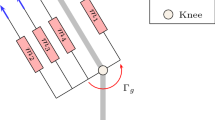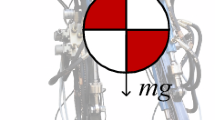Abstract
This paper presents a control algorithm for push recovery, which particularly focuses on the hip strategy when an external disturbance is applied on the body of a standing under-actuated biped. By analyzing a simplified dynamic model of a bipedal robot in the stance phase, it is found that horizontal stability can be maintained with a suitably controlled torque applied at the hip. However, errors in the angle or angular velocity of body posture may appear, due to the dynamic coupling of the translational and rotational motions. To solve this problem, different hip strategies are discussed for two cases when (1) external disturbance is applied on the center of mass (CoM) and (2) external torque is acting around the CoM, and a universal hip strategy is derived for most disturbances. Moreover, three torque primitives for the hip, depending on the type of disturbance, are designed to achieve translational and rotational balance recovery simultaneously. Compared with closed-loop control, the advantage of the open-loop methods of torque primitives lies in rapid response and reasonable performance. Finally, simulation studies of the push recovery of a bipedal robot are presented to demonstrate the effectiveness of the proposed methods.
Similar content being viewed by others
References
Ahmed, S.M., Chew, C.M., Tian, B., 2013. Standing posture modeling and control for a humanoid robot. Proc. IEEE/RSJ Int. Conf. on Intelligent Robots and Systems, p.4152-4157. [doi:10.1109/IROS.2013.6696951]
Azevedo, C., Espiau, B., Amblard, B., et al., 2007. Bipedal locomotion: toward unified concepts in robotics and neuroscience. Biol. Cybern., 96(2):209–228. [doi:10.1007/s00422-006-0118-0]
Horak, F.B., Nashner, L.M., 1986. Central programming of postural movements: adaptation to altered supportsurface configurations. J. Neurophysiol., 55(6):1369–1381.
Hyon, S., Hale, J.G., Cheng, G., 2007. Full-body compliant human-humanoid interaction: balancing in the presence of unknown external forces. IEEE Trans. Robot., 23(5):884–898. [doi:10.1109/TRO.2007.904896]
Kajita, S., Tani, K., 1991. Study of dynamic biped locomotion on rugged terrain-derivation and application of the linear inverted pendulum mode. Proc. IEEE Int. Conf. on Robotics and Automation, p.1405-1411. [doi:10.1109/ROBOT.1991.131811]
Lee, S.H., Goswami, A., 2010. Ground reaction force control at each foot: a momentum-based humanoid balance controller for non-level and non-stationary ground. Proc. IEEE/RSJ Int. Conf. on Intelligent Robots and Systems, p.3157-3162. [doi:10.1109/IROS.2010.5650416]
Li, Z., Vanderborght, B., Tsagarakis, N.G., et al., 2012. Stabilization for the compliant humanoid robot COMAN exploiting intrinsic and controlled compliance. Proc. IEEE Int. Conf. on Robotics and Automation, p.2000-2006. [doi:10.1109/ICRA.2012.6224705]
Liu, C., Atkeson, C.G., 2009. Standing balance control using a trajectory library. Proc. IEEE/RSJ Int. Conf. on Intelligent Robots and Systems, p.3031-3036. [doi:10.1109/IROS.2009.5354018]
Orin, D.E., Goswami, A., Lee, S.H., 2013. Centroidal dynamics of a humanoid robot. Auton. Robots, 35(2-3):161–176. [doi:10.1007/s10514-013-9341-4]
Pratt, J., Carff, J., Drakunov, S., et al., 2006. Capture point: a step toward humanoid push recovery. Proc. IEEE-RAS Int. Conf. on Intelligent Robots, p.200-207. [doi:10.1109/ICHR.2006.321385]
Runge, C.F., Shupert, C.L., Horak, F.B., et al., 1999. Ankle and hip postural strategies defined by joint torques. Gait Post., 10(2):161–170. [doi:10.1016/S0966-6362(99)00032-6]
Spong, M., 1995. The swing up control problem for the acrobat. IEEE Contr. Syst., 15(1):49–55. [doi:10.1109/37.341864]
Stephens, B., 2007a. Humanoid push recovery. Proc. IEEERAS Int. Conf. on Humanoid Robots, p.589-595. [doi:10.1109/ICHR.2007.4813931]
Stephens, B., 2007b. Integral control of humanoid balance. Proc. IEEE/RSJ Int. Conf. on Intelligent Robots and Systems, p.4020-4027. [doi:10.1109/IROS.2007.4399407]
Stephens, B., Atkeson, C.G., 2010. Dynamic balance force control for compliant humanoid robots. Proc. IEEE/RSJ Int. Conf. on Intelligent Robots and Systems, p.1248-1255. [doi:10.1109/IROS.2010.5648837]
Wang, J., 2012. Humanoid push recovery with robust convex synthesis. Proc. IEEE/RSJ Int. Conf. on Intelligent Robots and Systems, p.4354-4359. [doi:10.1109/IROS.2012.6386211]
Wang, Y., Xiong, R., Zhu, Q., et al., 2014. Compliance control for standing maintenance of humanoid robots under unknown external disturbances. Proc. IEEE Int. Conf. on Robotics and Automation, p.2297-2304. [doi:10.1109/ICRA.2014.6907177]
Whitman, E.C., Stephens, B.J., Atkeson, C.G., 2012. Torso rotation for push recovery using a simple change of variables. Proc. IEEE-RAS Int. Conf. on Humanoid Robots, p.50-56. [doi:10.1109/HUMANOIDS.2012.6651498]
Author information
Authors and Affiliations
Corresponding author
Additional information
Project supported by the National Natural Science Foundation of China (Nos. 51405430 and 61473258) and the National High-Tech R&D Program (863) of China (No. 2012AA041703)
ORCID: Chao LI, http://orcid.org/0000-0001-7625-4996
Rights and permissions
About this article
Cite this article
Li, C., Xiong, R., Zhu, Qg. et al. Push recovery for the standing under-actuated bipedal robot using the hip strategy. Frontiers Inf Technol Electronic Eng 16, 579–593 (2015). https://doi.org/10.1631/FITEE.14a0230
Received:
Accepted:
Published:
Issue Date:
DOI: https://doi.org/10.1631/FITEE.14a0230




